Basic Biology Introduction
- You know that in order to build a house, bricks are arranged in a certain pattern.
- Similarly, our body is made up of similar structures called cells, which assemble to form our body.
- Hence, cells are the structural units of our body. Living things are made up of tiny living parts or compartments called cells.
- Some living things, like bacteria and Amoeba, have only one cell (unicellular organisms).
Read And Learn More: NEET Class7 Biology Notes
- Large plants and animals contain billions of cells (multicellular organisms). Cells in multicellular organisms are of many different types, each type specially adapted for performing a particular job.
- Groups of cells of the same type make up the different tissues of the organism, e.g., muscle tissue.
- Several different types of tissues together form an organ, e.g., the stomach. A number of organs together form a system, e.g., the digestive system. A cell is the basic unit of living things or life.
Unicellular Organisms
- Living organisms made up of only a single cell are called unicellular organisms.
- Unicellular organisms can often be observed only with a microscope.
- Such living organisms are called microscopic, indicating that the organisms are too small to be seen with the naked eye.
Examples:
- Unicellular animals – Amoeba, Paramecium;
- Unicellular plants – Chlamydomonas, bacteria.
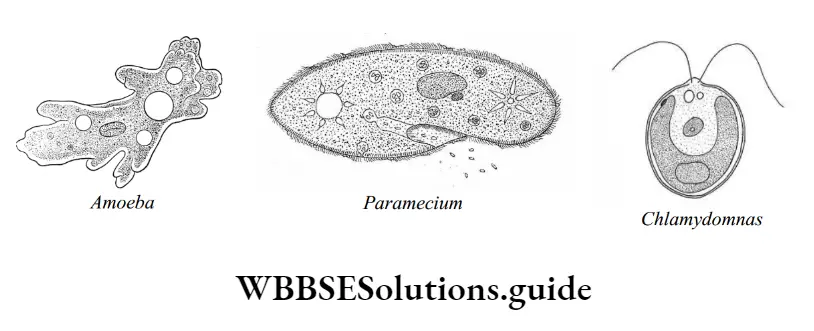
2. Discovery Of Cell
- The discovery of cells was first made by Robert Hooke. While examining a section of a cork tree under the microscope, he observed small compartment-like structures and named them cells.
- But, Hooke observed dead cells under the microscope as cork is made up of dead cells.
- After the discovery made by Hooke, very little came to be known about cells for a long time.
- This is because better microscopes were needed to study cells of living organisms.
- With the discovery of advanced microscopes (like electron microscopes), a study of the structure of cells and various cell organelles was made possible.
3. Cell Theory And Its Properties
Cell Theory
- The cell theory that all plants and animals are composed of cells and that the cell is the basic unit of life was presented by two biologists, Schleiden (1838) and Schwann (1839).
- The cell theory was further expanded by Rudolf Virchow in 1855. He suggested that all cells arise from pre-existing cells.
Principles Of Cell Theory
- All living organisms are composed of one or more cells.
- Cells are the basic unit of structure and function in an organism.
- All cells come only from the reproduction of pre-existing cells.
Properties Of Cell
- The cell is the smallest living unit of life.
- It is so small that it is not visible to the naked eye.
- The shape of the cell varies in different organisms and within an organism.
- The size of cells also differs.
- All living cells exhibit certain basic properties like respiration, growth, metabolism etc.
- Cells originate from a pre-existing cell. A mother cell divides to produce daughter cells. Hence, cells exhibit cell division.
4. Cell Organalle And Their Function
- All the life functions take place in every cell. A cell itself is made of certain parts.
- Also, plant and animal cells are not exactly alike. All plant and animal cells have three cell parts – the cell membrane, the cytoplasm and the nucleus.
- Each cell consists of a mass of living matter called protoplasm. The cytoplasm surrounded by the cell membrane and enclosing the nucleus together constitute the protoplasm (proto = first; plasm = form).
- Protoplasm, in other words, includes the cell membrane, the cytoplasm and the nucleus.
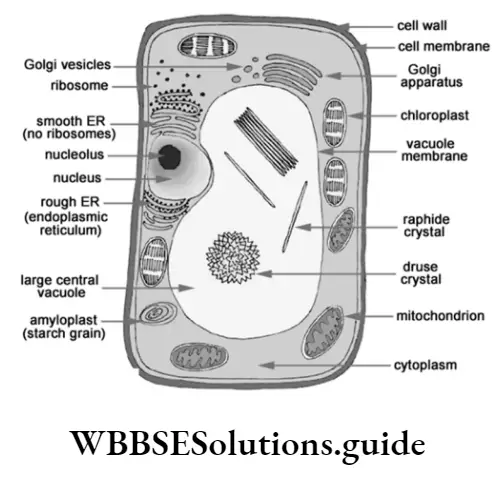
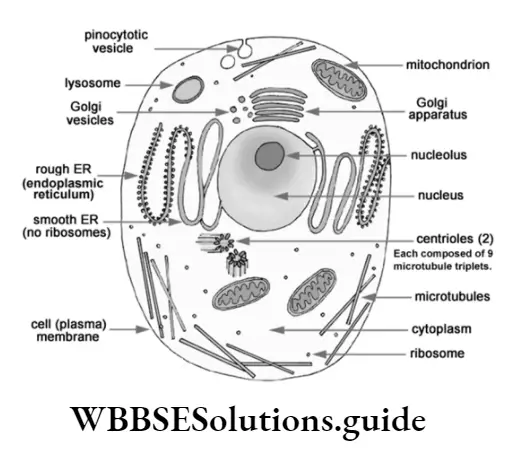
Cell Membrane
Also called the plasma membrane, it is a very thin skin covering the cell. There are very tiny holes in the cell membrane.
The plasma membrane performs the following functions:
- It protects the cell,
- It provides shape to the cell,
- It allows materials to enter and leave the cell through the tiny openings.
Cytoplasm
- The cytoplasm is a jelly-like substance occupying most of the inside of the cell.
- It occupies the space between the cell membrane and the nucleus. All the life functions take place in the cytoplasm.
- The cytoplasm contains many important tiny structures called organelles which perform various life functions.
Nucleus
- The nucleus is present inside the cell, surrounded by the cytoplasm. The nucleus is the boss of the cell, just like your school principal.
- Just as the principal controls everything taking place in the school, the nucleus also controls everything that happens in the cells.
- Most cells have only one nucleus. Cells like the muscle cells have more than one nucleus.
The nucleus is a spherical body consisting of four parts:
- Nuclear membrane
- Nuclear sap or nucleoplasm
- Nucleolus (plural nucleoli)
- Chromosomes.
The outermost covering layer of the nucleus is called the nuclear membrane. It separates the nucleus from the cytoplasm.
The nuclear membrane, like the cell membrane, has tiny holes in it which allow the exchange of substances between the nucleus and the cytoplasm.
The jelly-like fluid inside the nucleus is called the nucleoplasm. Chromosomes and nucleoli are present in the nucleoplasm.
Chromosomes are thread-like structures that play an important role in the inheritance of characters from one generation to another, that is, from the parents to the children.
Functions of the Nucleus
- Transmission of characters from one generation to another,
- Controls all the life functions taking place inside the cell.
Cell Organelles And Their Functions
A number of organelles occur in the cytoplasm. These include:
Mitochondria
- The mitochondrion is a membrane-enclosed organelle found in eukaryotic cells. Mitochondria are responsible for the production of most of the energy (or ATP) in cells.
- Therefore, mitochondria are also known as the powerhouse of cells. A mitochondrion is composed of two lipid membranes, enclosing the matrix.
- The inner membrane gets folded to form numerous cristae. Cristae are the main
site for ATP production. The mitochondrial matrix contains mitochondrial DNA and ribosomes.
Functions of mitochondria
- They produce energy required for cells in the form of ATP.
- They also regulate the free calcium ion concentration in the cytosol.
- They participate in apoptosis or programmed cell death.
Endoplasmic Reticulum
- The endoplasmic reticulum, or ER, is an interconnected network of membranous structures like tubules, vesicles, and cisternae. Cisternae are the flattened disk-like membranous structures.
- Tubules are tubular in shape, while vesicles are sac-like structures.
- There are two types of endoplasmic reticulum, namely smooth endoplasmic reticulum (SER) and rough endoplasmic reticulum (RER).
- When ribosomes get attached to the surface of the smooth endoplasmic reticulum, it becomes a rough endoplasmic reticulum.
The basic functions of the endoplasmic reticulum are
- To provide internal support to the cells
- To provide transportation pathways within the cells
Plastids
- Take a peel of the Tradescantia leaf and observe it under the microscope. You will find coloured bodies in the cytoplasm of the leaf cells. Do you know what these are? These are called plastids.
- The green-coloured plastids in the cell are known as chloroplasts. They are responsible for the green colour of the leaves.
- They carry out the process of photosynthesis and help plants prepare their own
food. - Plastids are major organelles found in plant cells and algae. There are two major types of plastids, namely Chromoplasts and leucoplasts.
- Chromoplasts are coloured plastids, while leucoplasts are white or colourless plastids.
- Chromoplasts contain coloured pigments like carotene (orange), xanthophylls (yellow) etc.
- These pigments are responsible for the colour of plants. Unlike chromoplasts, leucoplasts lack pigments.
Chloroplasts are plastids containing the pigment called chlorophyll. A chloroplast is enclosed by two lipid membranes.
They are called the kitchen of the cell.
The inner matrix is called the stroma. Thylakoids are the sub-organelles arranged in stacks within the stroma to form grana. The thylakoids are believed to be the main site for photosynthesis.
Plastids also contain their own DNA and ribosomes.
Functions of plastids
- They carry out the process of photosynthesis.
- They contribute to the colour of leaves, flowers etc.
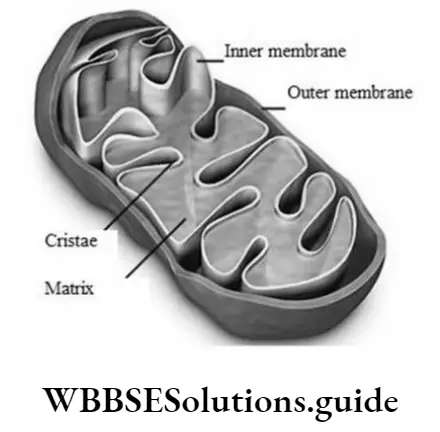
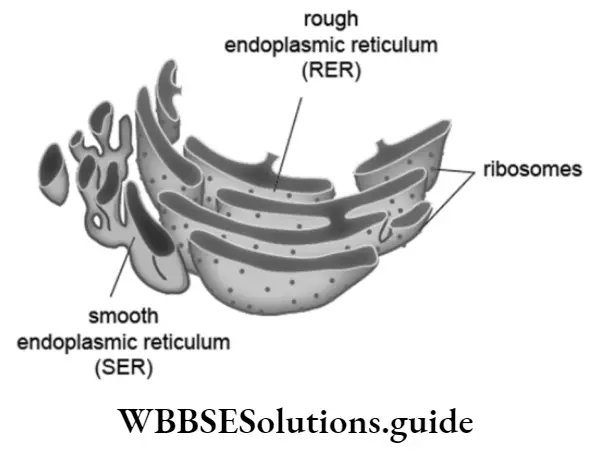
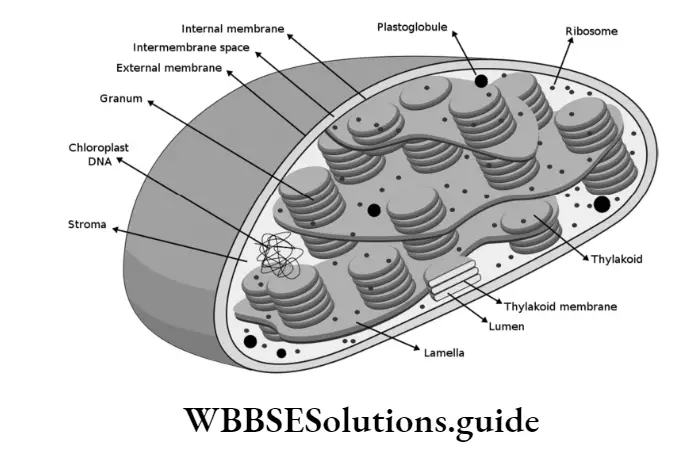
Golgi Complex
Golgi apparatus are the membrane-bound, sac-like structures called cisternae and some small vesicles.
- They are arranged parallel to each other in stacks.
- They were discovered by Camillo Golgi in 1898.
- The Golgi body is usually composed of five to eight cisternae in stacks.
- Some functions of the Golgi apparatus are enlisted below.
Functions of Golgi apparatus
- It involves the transport of lipids in cells.
- It involves the formation of lysosomes.
- It is involved in the synthesis of cell walls in the plant cell.
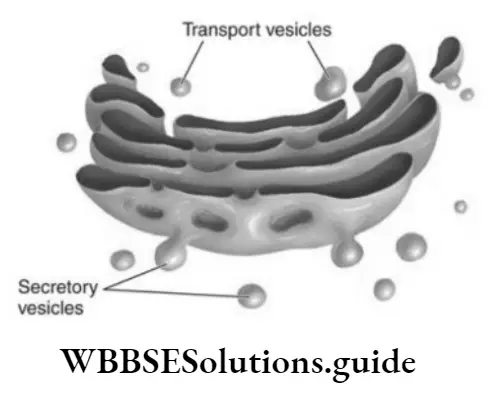
The Golgi apparatus present in the plant cell is called dictyosomes. They are small, unconnected and more in number as compared to the animal cell.
Lysosomes
Lysosomes are membrane-bound vesicles, which contain digestive (hydrolytic) enzymes. They digest a variety of substances including worn-out organelles, food particles, viruses, and bacteria.
They are also known as ‘suicide-bags’ of cells as they burst out and release hydrolytic enzymes in the cytosol, where cells are heavily injured.
Functions of lysosomes
They digest macromolecules by phagocytosis. So, they provide protection to the cell against foreign substances.
They also take part in auto-cell lysis.
Centrioles And Centrosomes (Present Only In Animals)
- Centrosome is found exclusively in animal cells. It lies very close to the nucleus.
- It contains two cylindrical structures called centrioles. Both centrioles in a centrosome lie perpendicular to each other.
- Centrioles have a cartwheel-like organisation. The centriole has a role in cell division.
Vacuole
- When you observe an onion peel under the microscope, you will observe large empty spaces in the cells.
- Do you know what these spaces are? These empty spaces are called vacuoles. These vacuoles are larger in plant cells than in animal cells.
- Vacuoles are membrane-bound structures, which are believed to store substances of cells.
- In plant cells, vacuoles are large in size, while in animal cells vacuoles are small. The table given below lists some functions of vacuoles. The membrane of vacuoles is called tonoplast.
Functions of vacuoles:
- They help in the removal of unwanted structural debris.
- They store all the waste products of cells.
- In Amoeba, food vacuoles store food.
Cell Inclusions
- Cell inclusions are the result of various chemical reactions that take place inside the cell, either in the cytoplasm or in the vacuole.
- Cell inclusions may be food products like starch or oil globules or waste materials like gums, resins, tannins, and latex.
Cell Wall
The cell wall is an extra covering that surrounds the cell membrane of a plant cell. It is made of a stiff, non-living material called cellulose. The cell wall is lacking in animal cells.
Functions:
- It provides rigidity to the cell.
- It provides protection to the cell.
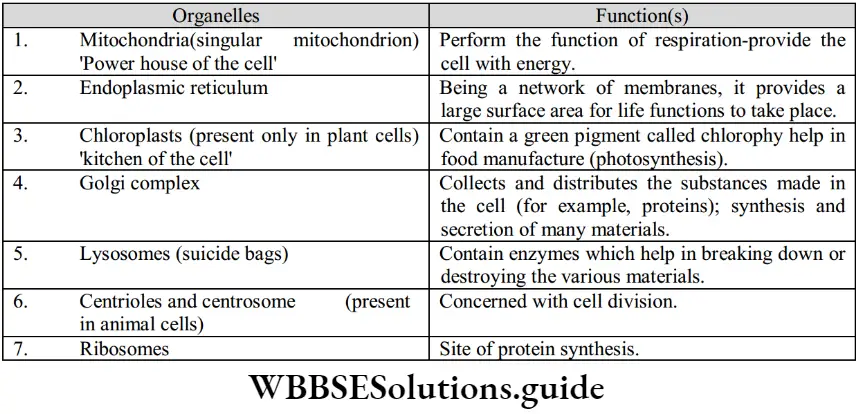
Features shared between Plant and Animal Cells
- The plasma membrane is present in both.
- Nucleus present in both.
- Mitochondria are present in both.
- The endoplasmic reticulum, Golgi complex, lysosomes and ribosomes are present in both.

3. Diversity In Cells
- So far we have considered the basic features of cells in general. However, this does not mean that all cells are identical.
- Structures like the nucleus, mitochondria, and cytoplasm are common to virtually all cells, but the shape, size and contents of individual cells show a lot of variation.
- These features are closely linked to the functions which the cells perform. In a unicellular organism, all the functions of the body, like nutrition, respiration, excretion, growth and reproduction are carried by a single cell.
- In a multicellular organism, however, these tasks or functions are divided among groups of cells.
- All the cells do not do all the jobs. This feature of multicellular organisms is known as division of labour.
- The group of cells show variability in their shape, size and other features depending upon the function being performed by them.
Cell Number
- Unicellular organisms are formed of single cells. Multicellular organisms are formed of many cells, which in turn may be of many types.
- Even in multicellular organisms, the number of cells may vary a lot. It may be just a few (as in some algae), to a few hundred (as in some algae) to several million (as in most plants and animals).
Cell Size
- Some plant and animal cells are visible to the naked eye. Most cells, however, are visible only with a microscope.
- For example, an ostrich egg is the largest animal cell. It is as big as 170 × 135 mm.
- The smallest known cell is that of a bacterium, PPLO. This bacterium measures about 0.1 to 0.5 microns (micrometres) in size.
- In plants, some algae have very big cells. For example, an alga, Acetabularia (a unicellular organism), consists of a single cell that is about ten centimetres in length.
- In our body, nerve cells are the largest, measuring about 90 micrometres in length. Some nerve cells are longer than a metre.
- Some blood cells are the smallest. Most other cells (such as that of the kidney, liver, intestine, etc.) are between 20 to 30 microns (micrometres) in length.
Cell Shape
- Cells are of diverse shapes. Some cells like those of Amoeba and white blood cells of our blood continuously change their shapes. Most cells, however, maintain a constant shape all through their existence.
- The shape of a cell is related to its function. A nerve cell clearly exhibits this relationship. It is long and has thread-like projections, as it has to convey messages to different parts of the body.
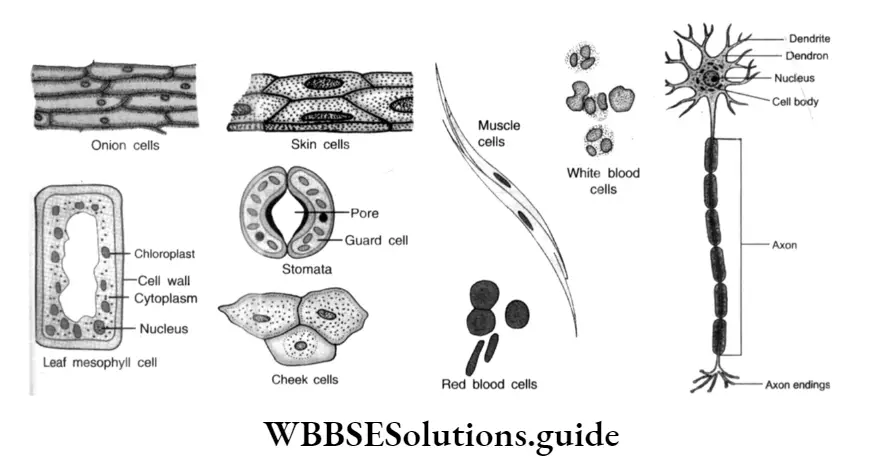
4. Cell Division
- An important characteristic of living beings is the capacity to reproduce. Cells do so. Cells arise only from other cells by a process called cell division.
- Most cells are capable of growing and splitting into two similar cells. The cells produced are called the daughter cells. These are identical to the mother cell.
- During the formation of daughter cells, the nucleus of the mother cell divides into two, so that each daughter cell gets one nucleus each. This is followed by the division of the cytoplasm.
- Finally, two daughter cells are formed. This mode of division is well exhibited by Amoeba, a unicellular organism.
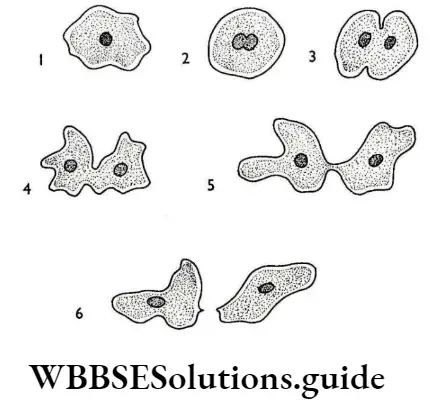
- In a multicellular organism, however, besides the cell dividing for reproduction, the body cells have to multiply for the growth of the organism itself.
- How does a small seedling grow into a big tree or does a young infant grow into an adult?
- This growth is brought about by an increase in the number of cells by cell division. The cells produced in due course of time undergo a change in size and shape.
- The whole organism, thus, shows overall growth. While plants grow throughout their life, animals grow up to a certain age and then stop growing.
Cell division in most organisms is of two types:
- Mitosis and
- Meiosis
Mitosis takes place in normal cells (vegetative or non-reproductive cells) of the body. It is responsible for the growth of organisms. Meiosis is the type of cell division which occurs only in the reproductive parts of the body.
It is a common observation that a child has some features of the mother and other ones of the father.
It is the meiotic division that is responsible for the passing on of characters from the two parents to the child.
Living things are made up of one or more cells. In unicellular organisms, like bacteria and amoeba, all life functions are performed by a single cell. In multicellular organisms, the cells are specialized to perform certain functions (division of labour).
Cells have three parts. The outer covering (cell membrane) encloses a jelly-like cytoplasm. Within the cytoplasm is the controlling centre of the cell,
In addition to the nucleus, cell organelles such as the chloroplast, mitochondria, endoplasmic reticulum, Golgi complex, centrosome and vacuoles are present in the cytoplasm.
Plant cells differ from animal cells in some respects. Cell walls and chloroplasts are present in plant cells and absent from animal cells. On the other hand, centrosome is present in animal cells and absent from plant cells.
- Cells show great variation in their sizes and shapes.
- New cells for growth and reproduction are formed by cell division.

